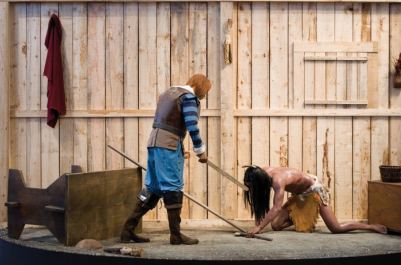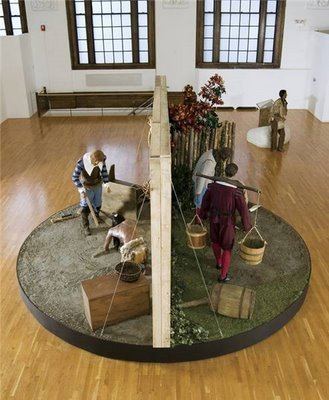Seattle is the last stop for The Old, Weird America: Folk Themes in American Art, and Seattle is lucky to get it. As
art museums hunker down with long runs for exhibits featuring objects from their
collections, fewer shows travel. If the recession is over,
nobody told the art world.
The Old, Weird America would be welcome at any time. Organized by Toby Kamps, senior curator at the Contemporary Arts Museum Houston, the exhibit opened in Houston in May, 2008, and debuted at the Frye Art Museum on Saturday, just in time for Thanksgiving.
A review will follow but given the season, I’d like to consider separately Sam Durant‘s Pilgrims and Indians, Planting and Reaping, Learning and Teaching. Its revolving-stage, dual dioramas invite the audience to contemplate who is weirder: those who insist on a fictionalized version of American history or those who dispute it.

 Durant purchased the dioramas from the defunct Plymouth National Wax Museum in Massachusetts. Initially, the museum displayed the accurate version of Thanksgiving’s origins: After Pequot Indian Pecksuot insulted Captain Myles Standish, Standish flew into a rage and killed him. Fearing retribution from Pecksuot’s tribe, Standish organized a raiding party and wiped out the Indians camped nearby. Afterward, settlers celebrated their win by declaring a national day of thanksgiving.
Durant purchased the dioramas from the defunct Plymouth National Wax Museum in Massachusetts. Initially, the museum displayed the accurate version of Thanksgiving’s origins: After Pequot Indian Pecksuot insulted Captain Myles Standish, Standish flew into a rage and killed him. Fearing retribution from Pecksuot’s tribe, Standish organized a raiding party and wiped out the Indians camped nearby. Afterward, settlers celebrated their win by declaring a national day of thanksgiving.
Over the years, the story transformed into its opposite: Pilgrims breaking not bones but bread with the land’s original occupants.
The factual diorama was removed after visitor complaints in the 1970s, leaving the story we know so well.
Reviewing the show for the Boston Globe, its art critic Sebastian Smee trotted out the usual insults for anyone questioning a master narrative from America the beautiful. Smee bemoaned the inclusion of:
familiar forms of patronizing “identity art” – art that addresses, in
the most dutiful, box-ticking ways, the familiar tropes of exclusion
and wrongdoing.
(Two familiars in one sentence? Maybe the Globe no longer deserves its reputation for great editors. I also note with dismay Smee’s lead, which for no good reason is in the passive voice. Had he wanted to leave a snail’s trail of inertia across his copy, passive would serve him. If not, not. )
Back to Smee:
I’m thinking, for instance, of Sam Durant’s two life-size dioramas that
suggest alternative interpretations of the first Thanksgiving. The
dioramas are set up on a circular platform, divided in half, that
slowly revolves. One side shows a Native American teaching a pilgrim
how to grow corn (with the help of a buried herring); the other shows
Captain Myles Standish beating to death the Pequot Indian Pecksuot,
which, the catalog tells us, led to a raid on the Pequots and
subsequent celebration.
Durant purchased both displays from the defunct Plymouth National Wax
Museum in Massachusetts. But to what end? The work he has made from
them is as didactic and kitsch as the originals, and it isn’t saved
from being so by the artist’s ironic know-ingness.
American exceptionalism means Americans never have to say they’re sorry.
Smee fell into the trap of reviewing the subject matter, not the art. I don’t mean to imply the trap is easy to avoid. Personally, I’m relieved to see accuracy creeping into American history by way of art or any other way, if only because too many American myths are found there and fuel attitudes that impede progressive change.
In reacting to Durant, I have to consider whether I am Smee’s twin, responding to what art says rather than what it is. And yet I think it is what it needs to be, an appropriation of frozen moments he sets in motion, fact and fantasy as each other’s form and each other’s shadow.



I did not know this. I think of all those turkeys and pilgrims I cut out and colored in grade school, and I want to scream. Thanks for nothing, Thanksgiving.
Revisionist History 101 – PULLEASE. The White Man treated the aboriginal residents badly – We all know that – but this bit of ‘history’ is a pathetic attempt to make things (unnecessarily) worse than they really are. What does anyone gain from this fiction? It is 2009 – do you think for one second that if this were really true that we would not have heard about it ALOT every November for the past 50 years?
Hello WR Pickard: Unless you’re reading Howard Zinn and/or Sarah Vowell, such information is hard to come by. The catalog for “The Old, Weird America” quotes original sources. Contemporary historians tend to treat the standard version of Thanksgiving as a harmless fantasy. Your faith in your country’s ability to come clean about its past is touching but ill-founded. Many have tried, and they are shouted down as tiresome leftists. A style note: The English language is wide and deep. There’s no reason to resort to the non-word PULLEASE, in all caps, no less. That formation is past its pull date. Thank you for reading my blog, and for writing a response with your name on it. Regina
Who wouldn’t be more comfortable with the canonized version of American history? It’s tough to confront the reality of the legacy we’ve inherited, but the only way we can move forward is through making a virtue of honesty.
For our friends who would prefer not to deal with art that aims for honesty, may I suggest that you only look at this painting for the rest of your life?
http://www.mcnaughtonart.com/artwork/view_zoom/?artpiece_id=353
(via Jen Graves)